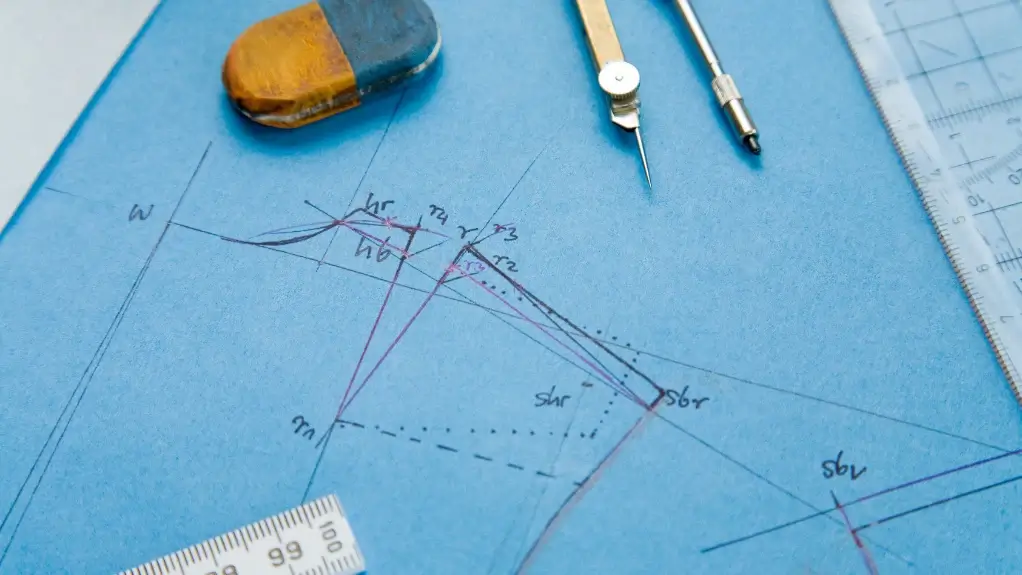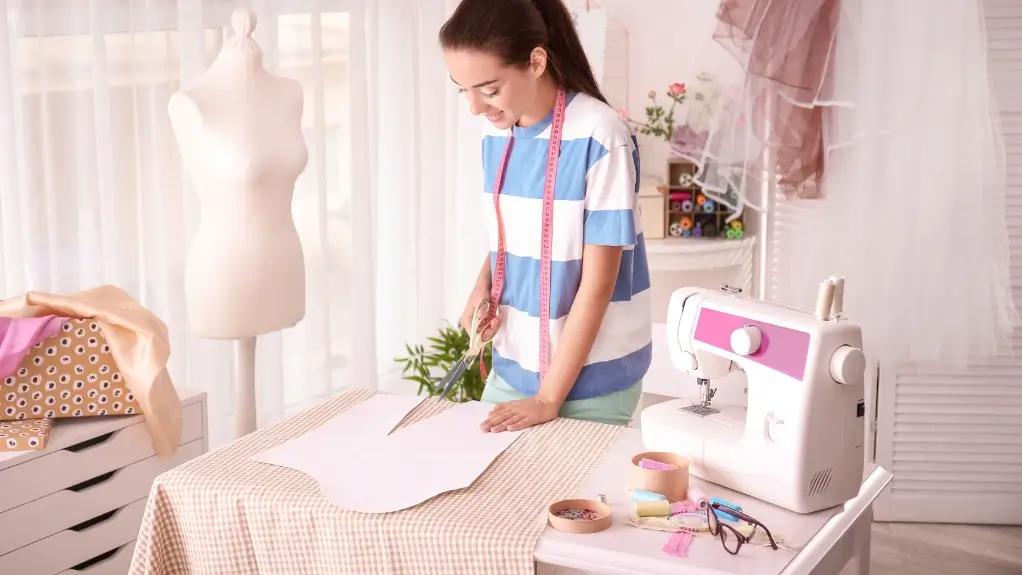Darts are essential elements in garment construction. They serve as strategic folds that transform flat fabric into three-dimensional shapes.
Whether you're working with bodices, skirts, or tailored pieces, these triangular or diamond-shaped tucks help achieve the right fit and shape.
Each type of dart offers specific advantages for different garment areas and body contours. So, understanding their distinct purposes will enhance your ability to achieve professional-level results.
15 Different Types of Darts in Sewing

Darts consist of two main parts: the point, often referred to as the apex, and the legs, which begin at the widest section of the dart.
1. Single-Pointed Darts (Plain Darts)
Single-pointed darts serve as essential shaping elements. They create three-dimensional forms from flat fabric.
In sewing patterns, darts extend from the garment's seam edge and taper to a precise point. They're versatile elements that can be placed vertically, horizontally, or diagonally for a tailored fit.
Single-pointed darts can be used to shape bodices, skirts, and other fitted garment sections where contoured shaping is needed.
2. Double-Pointed Darts (Fish-Eye Darts)
Double-pointed darts provide superior contouring through their distinctive dual-point construction. These darts are essential in fitted garments where both bust and waist shaping are needed.
It's similar to having two darts connected at their widest parts, with one end pointing toward the bust and the other toward the waist.
When sewing double-pointed darts, start at the widest center point and stitch toward each vanishing point. This technique ensures precise shaping and prevents fabric distortion.
You'll need to clip the center to release tension carefully. But don't cut too close to the stitching line.
3. Curved Darts
Curved shaping techniques offer superior adaptability for complex body contours. They're particularly effective in achieving a more refined silhouette. Because they follow the body's natural curves with greater accuracy than straight darts.
When using curved darts, you'll need to focus on precise sewing techniques to prevent puckering and ensure smooth contouring.
These shaping elements are versatile. They can be sewn in either concave or convex directions based on your garment's needs.
4. Contour Darts
Contour darts are a refined double-pointed shaping technique. They're crucial for getting a precise fit in tailored garments.
These double-pointed darts are strategically placed to shape both hip and bust areas. They create a seamless silhouette in fitted clothing.
When sewing contour darts, begin at the widest point and work toward each vanishing point one at a time.
For large dart intakes, clip at the widest section to relieve tension and achieve smooth shaping.
5. French Darts
French darts are a unique shaping technique. They stand out from standard contour darts because of their elongated construction.
These darts begin near the waistline and gracefully taper toward the bust point. They seamlessly integrate both waist and bust shaping in a single element.
It's essential to test your French dart placement on muslin first. Because their positioning significantly impacts the garment's final contoured fit.
6. Dart Tucks
Standard darts create crisp, defined shaping. But dart tucks offer a more fluid approach to garment contouring. They remain open at the tip to form gentle pleats.
When sewing dart tucks, you'll follow similar construction methods as traditional darts. But instead of securing the tip, you'll leave it open to create a pleated appearance in the fabric.
This technique works well in billowy garments, helping maintain shape while allowing movement. Proper marking ensures even pleats across the garment.
7. Elbow Darts
Elbow darts are key for getting the best fit in sleeves. They're strategic shaping elements that allow for the natural bend of your arm.
When working with sleeve pattern pieces, you'll find these darts taper precisely toward the elbow joint. This creates a tailored appearance that eliminates excess fabric bunching. Position them carefully to enhance both fit and comfort while maintaining the sleeve's professional finish.
8. Shoulder Darts
Shoulder darts are fundamental in achieving a precise fit across the shoulder area. These darts are strategically placed between the neckline and armhole. They create a fitted effect that follows the natural contours of your shoulders.
In tailored garments, shoulder darts provide essential structure and shape. They can enhance the overall silhouette.
Consider the angle and length carefully when constructing these darts. They're crucial for achieving proper contouring.
9. Neck Darts
Neck darts are located at the neckline of garments. They're crucial shaping elements that eliminate excess fabric and create a polished silhouette.
These darts point downward and away from the neck. They provide essential contouring in blouses, dresses, and tailored jackets.
To achieve a professional finish, you'll need to sew and press your neck darts precisely.
10. Bust Darts
Bust darts serve as fundamental shaping elements. They create dimension and professional fit in the chest area of garments.
Bust darts are often positioned two inches below the armhole, extending toward the bust point. In garment construction, these darts remove excess fabric and create a tailored fit that follows the body's natural shape.
11. Waist Darts
Waist darts are essential design features in garment construction. They provide structure and shape, enhancing the fit around the waistline.
These darts are typically located on the front and back of a garment. They help to eliminate excess fabric, allowing the garment to contour smoothly to the body's curves.
By directing the fabric towards the waist, these darts create a polished silhouette that flatters the figure and ensures comfort.
12. Skirt or Pant Darts
When creating tailored bottoms, skirt and pant darts are essential structural elements. They provide shape between the waist and hip areas.
These darts are positioned around the waistline. They taper toward the hip to eliminate excess fabric and create a smooth silhouette.
You can use single-pointed darts that begin at the waist and narrow to a point. Alternatively, you can choose double-pointed darts that shape both the waist and hip regions. For an enhanced fit, consider placing double darts on each side of the center seam.
13. Decorative Darts
Decorative darts offer an innovative approach to garment construction. They combine functional shaping with artistic expression.
These structural elements serve dual purposes in garment designs. They incorporate both fit and visual interest through strategic fabric manipulation.
When using decorative darts, you can try techniques like pintucks or ornamental stitching to add unique design details.
14. Princess Seams (Extended Darts)
Princess seams represent an advanced form of dart manipulation. They transform traditional darts into elegant vertical seam lines running from the shoulder or armhole to the hem.
These extended darts provide superior shaping capabilities. They contour seamlessly to your body's natural curves while eliminating the bulk often associated with conventional darts.
15. Serged Darts
Traditional dart construction relies on standard sewing machines. But serged darts offer a modern approach that's particularly effective for knit fabrics. This technique streamlines your sewing projects while maintaining professional results.
When you use a serger for dart construction, you'll achieve two key benefits: reduced bulk along the dart edges and enhanced stretch retention in knit fabrics.
The serged finish creates clean, professional seams that won't compromise your garment's flexibility.
How to Sew Darts: Common Tips

Accurate dart construction forms the foundation of well-fitted garments.
- Start by transferring markings to your fabric's wrong side using water-soluble markers.
- Fold and align the dart legs with the right sides together, then pin and baste for stability.
- Begin sewing at the widest part, securing with a backstitch. Sew toward the point without backstitching at the tip for smoothness.
- For curved darts, staystitch the seam line first and clip the intake.
- Finally, press the dart over a tailor's ham, directing vertical darts toward the center and side darts downward toward the hem.
Common Mistakes When Sewing Darts
Mastering dart construction requires awareness of several pitfalls that can compromise your garment's professional finish.
- When you transfer markings to the wrong location, you'll end up with misaligned dart legs that affect the fit.
- Not backstitching at the dart's wide end creates structural weakness.
- Incorrect stitch length near the point causes unsightly puckering.
- You'll need to properly press your darts using a tailor's ham to avoid bulky seams.
- Don't forget to trim excess fabric at the dart point, as this extra bulk can distort your garment's silhouette.
These technical details make the difference between amateur and professional-looking results.
Conclusion
Mastering these essential kinds of darts transforms your garment construction capabilities. Understanding the technical distinctions between single-pointed, fish-eye, and curved darts enables precise fitting adjustments.
When executing darts, maintain accurate stitching lines, proper pressing techniques, and consistent seam allowances. Remember to match thread tension and use marking methods for professional results.
These foundational shaping elements remain crucial for achieving a superior garment fit.
Learn more sewing tips on the Longan Craft Blog, and dive into the fabric world with Longan Craft!
FAQs
What Are the Different Types of Darts in Sewing?
You'll encounter five main dart types:
- Standard darts for basic shaping;
- French darts combining bust/waist control;
- Curved darts for body contouring;
- Double-ended (fisheye) darts for precise fitting;
- Dart tucks for decorative fullness.
What Are the Two Main Categories of Darts?
Single-pointed darts converge to one vanishing point. Double-pointed (fisheye) darts extend in opposite directions. They feature two vanishing points for contoured shaping.
What Is the Difference Between a Bustier and a Princess Dart?
Bustier darts extend from the side seam to the bust point. They create a single-pointed shape. But princess darts merge bust and waist shaping into one elongated line from shoulder to waist for smoother contouring.


0 comments